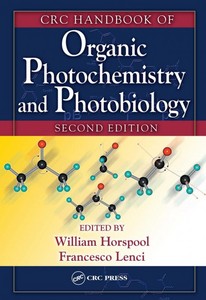Photoinduced electron-transfer processes of phthalimides
Oelgemöller, Michael, and Griesbeck, Axel G. (2004) Photoinduced electron-transfer processes of phthalimides. In: Horspool, William, and Lenci, Francesco, (eds.) CRC Handbook of Organic Photochemistry and Photobiology. CRC Press, Boca Raton, FL, USA, 84:1-84:19.
![[img]](https://researchonline.jcu.edu.au/9888/1.hassmallThumbnailVersion/9888_Oelgemoller_2004_Cover.jpg)
|
Image (JPEG) (Book Cover)
- Cover Image
Download (93kB) |
|
|
PDF (Published Version)
- Published Version
Restricted to Repository staff only |
Abstract
In terms of synthetic applications, the phthalimide system has attracted much attention over the past three decades, as noticeable by a number of summarizing reviews. Although the photochemistry of phthalimide derivatives is similar to that of carbonyl compounds, it covers additional reactivity features due to the remarkably high oxidizing power of the excited singlet and triplet states. Thus, the presence of energetically feasible electron donor groups leads to the generation of radical ions that can undergo nonproductive (back) electron transfer, direct radical ion combination, or mesolytic extrusion of a suitable leaving group (e.g., a proton, silyl cation, or carbon dioxide), respectively. The competition between these processes can be controlled by varying the redox potentials, the stability of the radical cations, and the leaving group ability. The photophysical and electrochemical properties of phthalimides are well documented. In acetonitrile, -alkylphthalimides show relatively unstructured UV absorption spectra with absorption maxima around 235 nm (π,π*) and 290 nm (π,π*), respectively. In ethanol or acetonitrile at room temperature, they exhibit weak fluorescence with low quantum yields (Φf < 1 × 10−3). In the absence of oxygen in alcohol, N-alkylphthalimides show broad structureless phosphorescence centered around 450 nm with quantum yields between Φp = 0.4–0.7 and triplet lifetimes of τp = 0.7–1.04 s (at −196°C). N-Methylphthalimide is reversibly reduced to the corresponding radical anion at ca. −1.35 V in DMF, and at ca. −1.5 V in acetonitrile (vs. SCE),respectively, but the presence of a hydrogen donor site in the side chain has a dramatic effect on the redox properties. Based on the available photophysical and electrochemical data, it is possible to estimate the feasibility of a photoinduced electron transfer (PET)for various phthalimide/donor pairs. The limiting maximum oxidation potential of the electron donorthus depends on the nature of the electronically excited state of the phthalimide electron acceptor and can be estimated from the Rehm-Weller equation. Thus, if the first excited singlet state is involved (E00= 3.8 eV), the limiting oxidizing power for an isoenergetic electron transfer is ca. 2.4 V (vs. SCE). If the first excited triplet state is involved (E00 = 3.1 eV), the limiting oxidizing power decreases to ca. 1.7 V(vs. SCE). In cases where the spectroscopically nondetectable second triplet state is populated (E00 = 3.6eV), the oxidizing power increases by about 500 mV.
| Item ID: | 9888 |
|---|---|
| Item Type: | Book Chapter (Research - B1) |
| ISBN: | 978-0-8493-1348-6 |
| Date Deposited: | 20 Oct 2011 02:10 |
| FoR Codes: | 03 CHEMICAL SCIENCES > 0305 Organic Chemistry > 030503 Organic Chemical Synthesis @ 100% |
| SEO Codes: | 97 EXPANDING KNOWLEDGE > 970103 Expanding Knowledge in the Chemical Sciences @ 100% |
| Downloads: |
Total: 332 Last 12 Months: 4 |
| More Statistics |



